BSc (Hons) Business Management - Types of Companies Report
VerifiedAdded on 2022/11/25
|12
|2958
|102
Report
AI Summary
This report provides a comprehensive analysis of different types of companies, including micro, small, medium, and large businesses, examining their characteristics and functions. It explores various forms of companies, ranging from sole traders to cooperatives and limited liability partnerships, detailing their structures and key features. Furthermore, the report delves into different business organizational structures, such as functional, divisional, and matrix structures, and discusses how these structures impact business productivity. The report also includes a PESTLE analysis to assess how external factors like political, economic, social, and technological aspects influence business performance, using Tesco as a case study to illustrate these concepts.
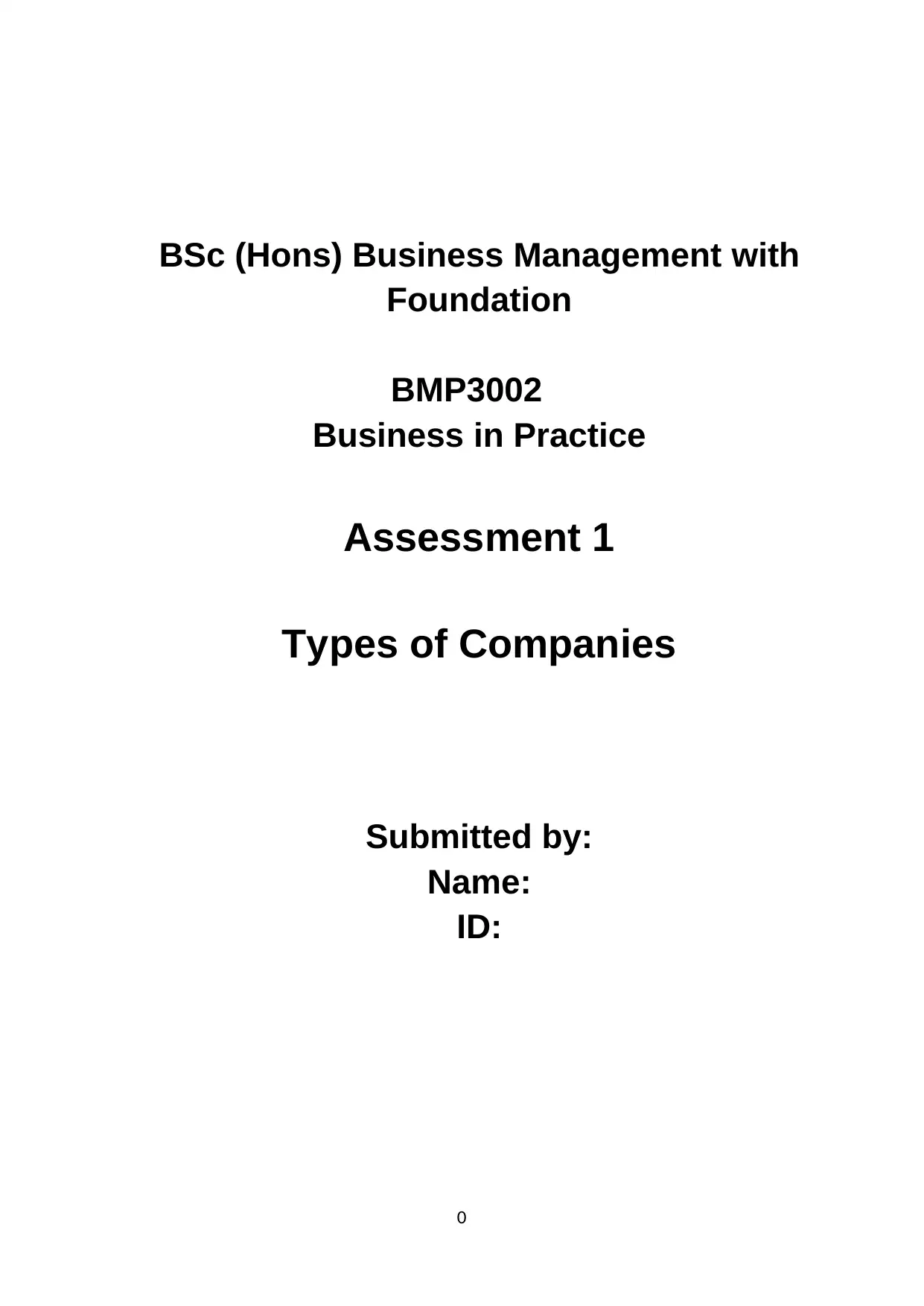
BSc (Hons) Business Management with
Foundation
BMP3002
Business in Practice
Assessment 1
Types of Companies
Submitted by:
Name:
ID:
0
Foundation
BMP3002
Business in Practice
Assessment 1
Types of Companies
Submitted by:
Name:
ID:
0
Paraphrase This Document
Need a fresh take? Get an instant paraphrase of this document with our AI Paraphraser
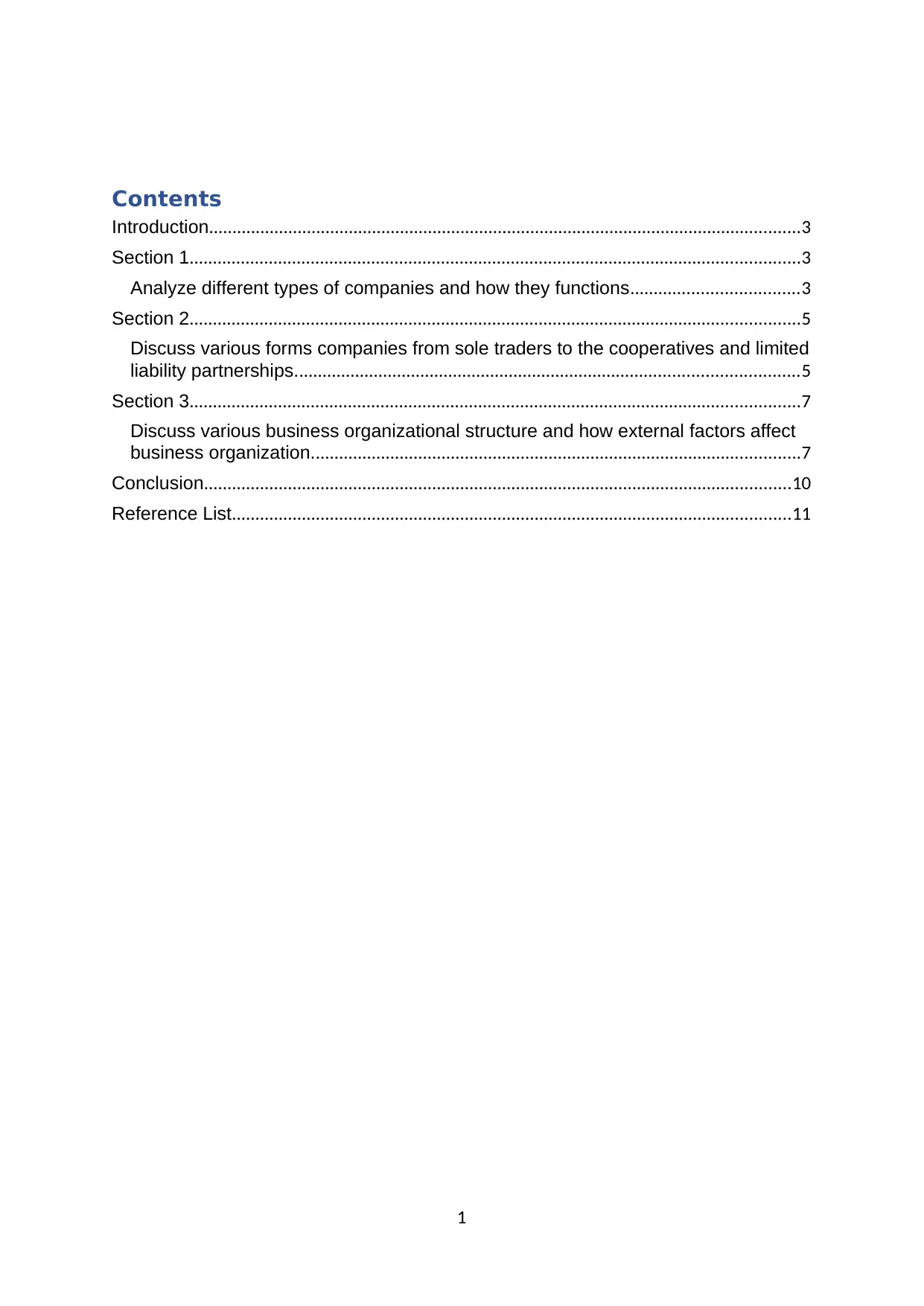
Contents
Introduction...............................................................................................................................3
Section 1...................................................................................................................................3
Analyze different types of companies and how they functions....................................3
Section 2...................................................................................................................................5
Discuss various forms companies from sole traders to the cooperatives and limited
liability partnerships............................................................................................................5
Section 3...................................................................................................................................7
Discuss various business organizational structure and how external factors affect
business organization.........................................................................................................7
Conclusion..............................................................................................................................10
Reference List........................................................................................................................11
1
Introduction...............................................................................................................................3
Section 1...................................................................................................................................3
Analyze different types of companies and how they functions....................................3
Section 2...................................................................................................................................5
Discuss various forms companies from sole traders to the cooperatives and limited
liability partnerships............................................................................................................5
Section 3...................................................................................................................................7
Discuss various business organizational structure and how external factors affect
business organization.........................................................................................................7
Conclusion..............................................................................................................................10
Reference List........................................................................................................................11
1

2
⊘ This is a preview!⊘
Do you want full access?
Subscribe today to unlock all pages.

Trusted by 1+ million students worldwide
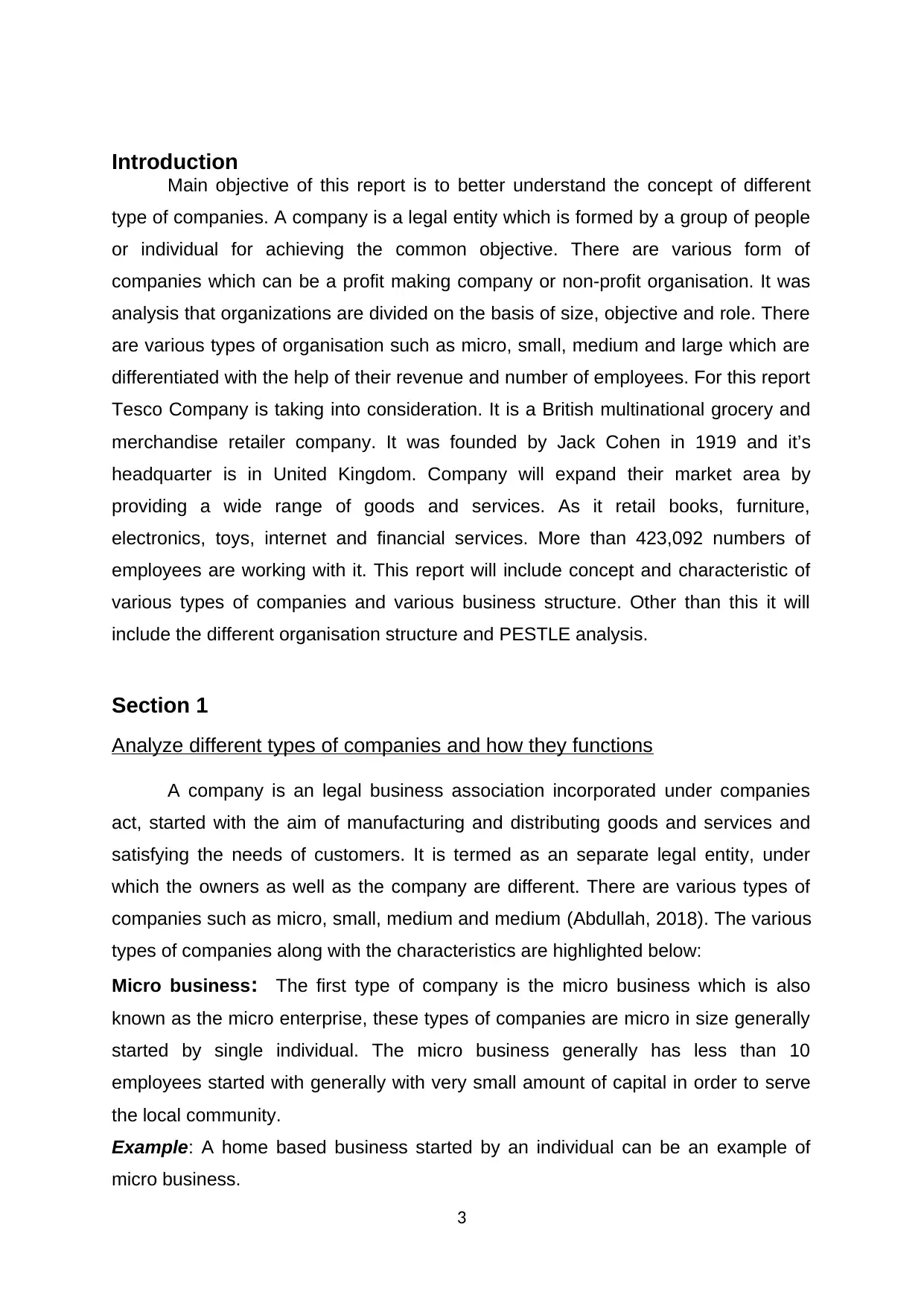
Introduction
Main objective of this report is to better understand the concept of different
type of companies. A company is a legal entity which is formed by a group of people
or individual for achieving the common objective. There are various form of
companies which can be a profit making company or non-profit organisation. It was
analysis that organizations are divided on the basis of size, objective and role. There
are various types of organisation such as micro, small, medium and large which are
differentiated with the help of their revenue and number of employees. For this report
Tesco Company is taking into consideration. It is a British multinational grocery and
merchandise retailer company. It was founded by Jack Cohen in 1919 and it’s
headquarter is in United Kingdom. Company will expand their market area by
providing a wide range of goods and services. As it retail books, furniture,
electronics, toys, internet and financial services. More than 423,092 numbers of
employees are working with it. This report will include concept and characteristic of
various types of companies and various business structure. Other than this it will
include the different organisation structure and PESTLE analysis.
Section 1
Analyze different types of companies and how they functions
A company is an legal business association incorporated under companies
act, started with the aim of manufacturing and distributing goods and services and
satisfying the needs of customers. It is termed as an separate legal entity, under
which the owners as well as the company are different. There are various types of
companies such as micro, small, medium and medium (Abdullah, 2018). The various
types of companies along with the characteristics are highlighted below:
Micro business: The first type of company is the micro business which is also
known as the micro enterprise, these types of companies are micro in size generally
started by single individual. The micro business generally has less than 10
employees started with generally with very small amount of capital in order to serve
the local community.
Example: A home based business started by an individual can be an example of
micro business.
3
Main objective of this report is to better understand the concept of different
type of companies. A company is a legal entity which is formed by a group of people
or individual for achieving the common objective. There are various form of
companies which can be a profit making company or non-profit organisation. It was
analysis that organizations are divided on the basis of size, objective and role. There
are various types of organisation such as micro, small, medium and large which are
differentiated with the help of their revenue and number of employees. For this report
Tesco Company is taking into consideration. It is a British multinational grocery and
merchandise retailer company. It was founded by Jack Cohen in 1919 and it’s
headquarter is in United Kingdom. Company will expand their market area by
providing a wide range of goods and services. As it retail books, furniture,
electronics, toys, internet and financial services. More than 423,092 numbers of
employees are working with it. This report will include concept and characteristic of
various types of companies and various business structure. Other than this it will
include the different organisation structure and PESTLE analysis.
Section 1
Analyze different types of companies and how they functions
A company is an legal business association incorporated under companies
act, started with the aim of manufacturing and distributing goods and services and
satisfying the needs of customers. It is termed as an separate legal entity, under
which the owners as well as the company are different. There are various types of
companies such as micro, small, medium and medium (Abdullah, 2018). The various
types of companies along with the characteristics are highlighted below:
Micro business: The first type of company is the micro business which is also
known as the micro enterprise, these types of companies are micro in size generally
started by single individual. The micro business generally has less than 10
employees started with generally with very small amount of capital in order to serve
the local community.
Example: A home based business started by an individual can be an example of
micro business.
3
Paraphrase This Document
Need a fresh take? Get an instant paraphrase of this document with our AI Paraphraser
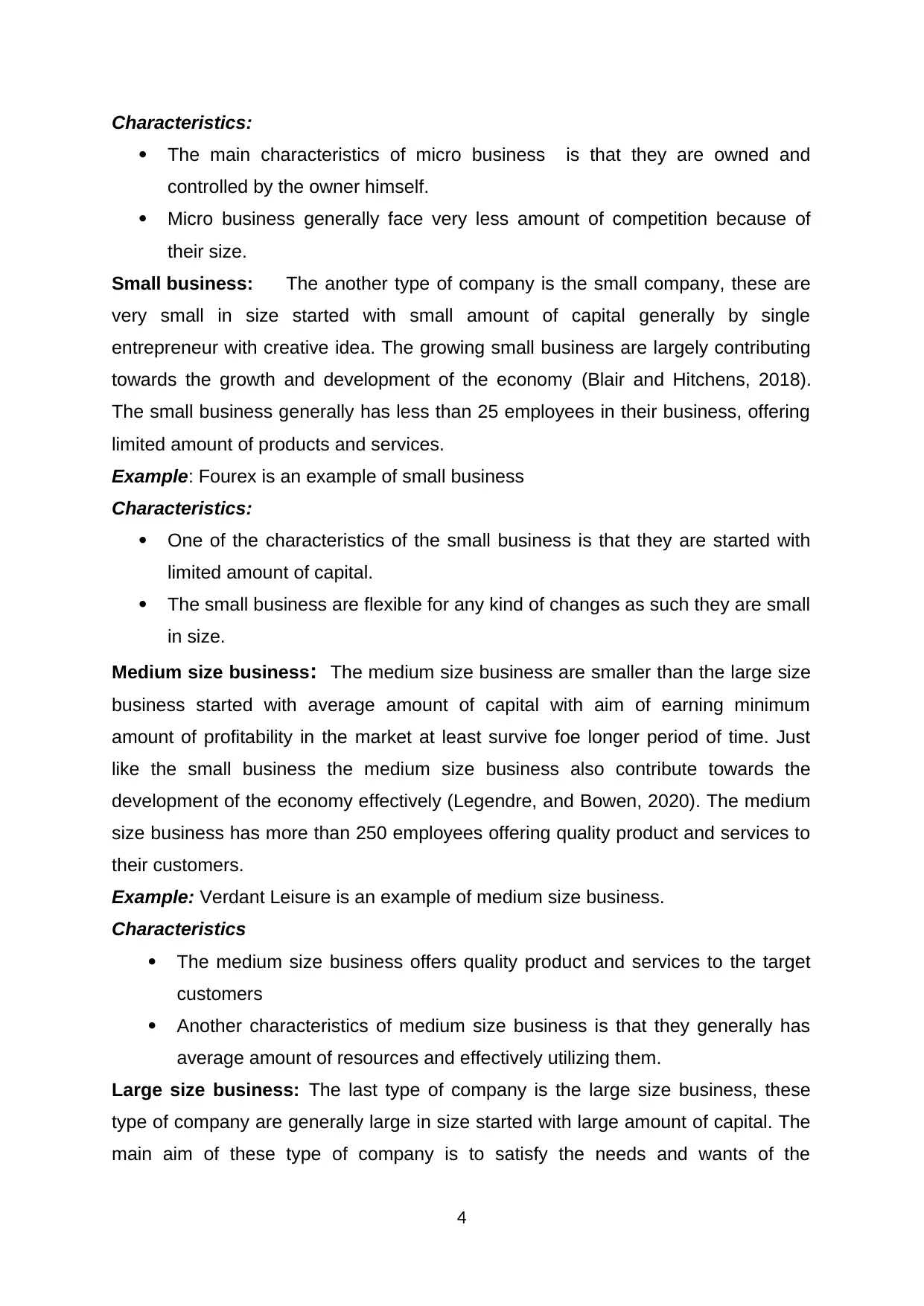
Characteristics:
The main characteristics of micro business is that they are owned and
controlled by the owner himself.
Micro business generally face very less amount of competition because of
their size.
Small business: The another type of company is the small company, these are
very small in size started with small amount of capital generally by single
entrepreneur with creative idea. The growing small business are largely contributing
towards the growth and development of the economy (Blair and Hitchens, 2018).
The small business generally has less than 25 employees in their business, offering
limited amount of products and services.
Example: Fourex is an example of small business
Characteristics:
One of the characteristics of the small business is that they are started with
limited amount of capital.
The small business are flexible for any kind of changes as such they are small
in size.
Medium size business: The medium size business are smaller than the large size
business started with average amount of capital with aim of earning minimum
amount of profitability in the market at least survive foe longer period of time. Just
like the small business the medium size business also contribute towards the
development of the economy effectively (Legendre, and Bowen, 2020). The medium
size business has more than 250 employees offering quality product and services to
their customers.
Example: Verdant Leisure is an example of medium size business.
Characteristics
The medium size business offers quality product and services to the target
customers
Another characteristics of medium size business is that they generally has
average amount of resources and effectively utilizing them.
Large size business: The last type of company is the large size business, these
type of company are generally large in size started with large amount of capital. The
main aim of these type of company is to satisfy the needs and wants of the
4
The main characteristics of micro business is that they are owned and
controlled by the owner himself.
Micro business generally face very less amount of competition because of
their size.
Small business: The another type of company is the small company, these are
very small in size started with small amount of capital generally by single
entrepreneur with creative idea. The growing small business are largely contributing
towards the growth and development of the economy (Blair and Hitchens, 2018).
The small business generally has less than 25 employees in their business, offering
limited amount of products and services.
Example: Fourex is an example of small business
Characteristics:
One of the characteristics of the small business is that they are started with
limited amount of capital.
The small business are flexible for any kind of changes as such they are small
in size.
Medium size business: The medium size business are smaller than the large size
business started with average amount of capital with aim of earning minimum
amount of profitability in the market at least survive foe longer period of time. Just
like the small business the medium size business also contribute towards the
development of the economy effectively (Legendre, and Bowen, 2020). The medium
size business has more than 250 employees offering quality product and services to
their customers.
Example: Verdant Leisure is an example of medium size business.
Characteristics
The medium size business offers quality product and services to the target
customers
Another characteristics of medium size business is that they generally has
average amount of resources and effectively utilizing them.
Large size business: The last type of company is the large size business, these
type of company are generally large in size started with large amount of capital. The
main aim of these type of company is to satisfy the needs and wants of the
4
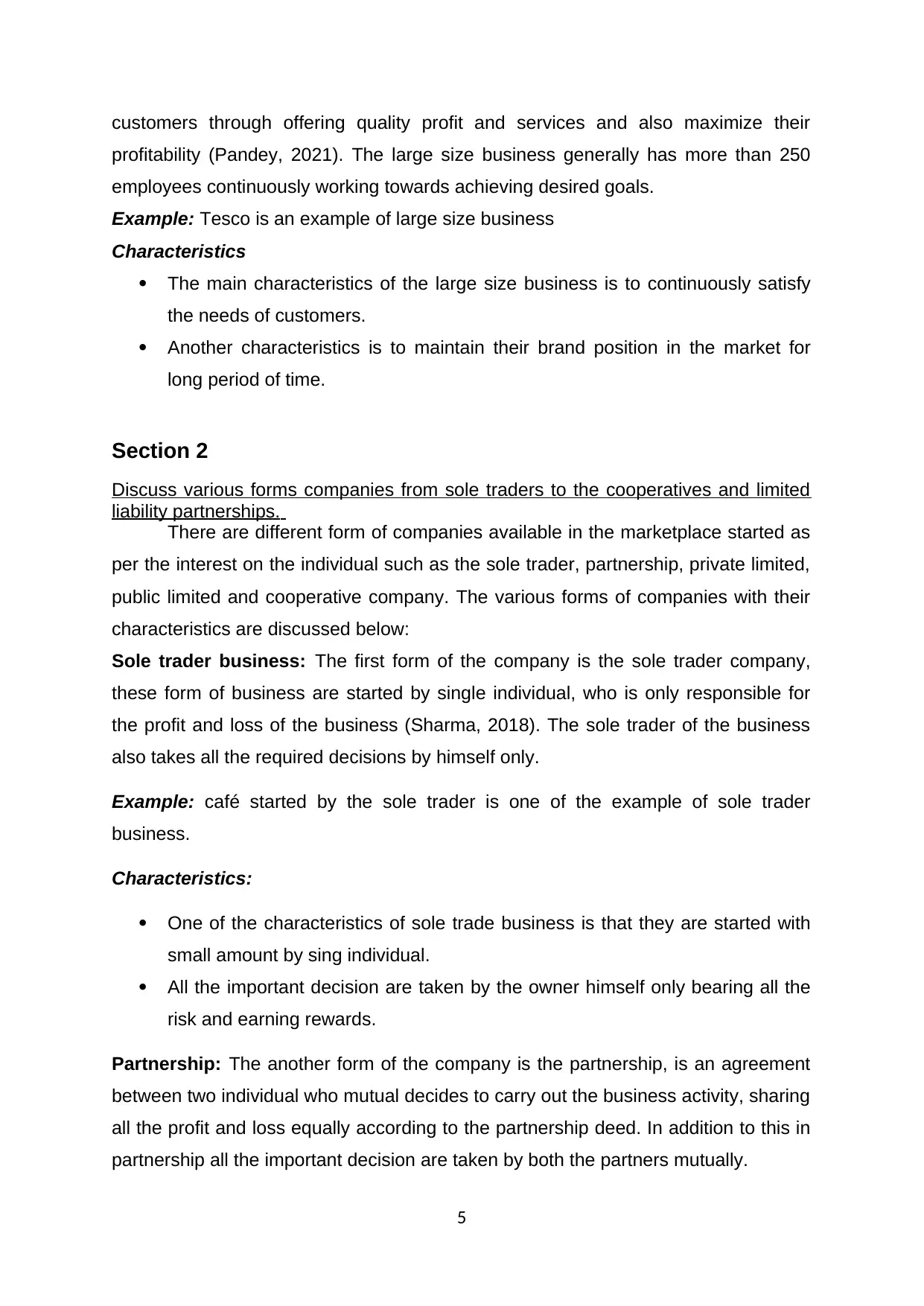
customers through offering quality profit and services and also maximize their
profitability (Pandey, 2021). The large size business generally has more than 250
employees continuously working towards achieving desired goals.
Example: Tesco is an example of large size business
Characteristics
The main characteristics of the large size business is to continuously satisfy
the needs of customers.
Another characteristics is to maintain their brand position in the market for
long period of time.
Section 2
Discuss various forms companies from sole traders to the cooperatives and limited
liability partnerships.
There are different form of companies available in the marketplace started as
per the interest on the individual such as the sole trader, partnership, private limited,
public limited and cooperative company. The various forms of companies with their
characteristics are discussed below:
Sole trader business: The first form of the company is the sole trader company,
these form of business are started by single individual, who is only responsible for
the profit and loss of the business (Sharma, 2018). The sole trader of the business
also takes all the required decisions by himself only.
Example: café started by the sole trader is one of the example of sole trader
business.
Characteristics:
One of the characteristics of sole trade business is that they are started with
small amount by sing individual.
All the important decision are taken by the owner himself only bearing all the
risk and earning rewards.
Partnership: The another form of the company is the partnership, is an agreement
between two individual who mutual decides to carry out the business activity, sharing
all the profit and loss equally according to the partnership deed. In addition to this in
partnership all the important decision are taken by both the partners mutually.
5
profitability (Pandey, 2021). The large size business generally has more than 250
employees continuously working towards achieving desired goals.
Example: Tesco is an example of large size business
Characteristics
The main characteristics of the large size business is to continuously satisfy
the needs of customers.
Another characteristics is to maintain their brand position in the market for
long period of time.
Section 2
Discuss various forms companies from sole traders to the cooperatives and limited
liability partnerships.
There are different form of companies available in the marketplace started as
per the interest on the individual such as the sole trader, partnership, private limited,
public limited and cooperative company. The various forms of companies with their
characteristics are discussed below:
Sole trader business: The first form of the company is the sole trader company,
these form of business are started by single individual, who is only responsible for
the profit and loss of the business (Sharma, 2018). The sole trader of the business
also takes all the required decisions by himself only.
Example: café started by the sole trader is one of the example of sole trader
business.
Characteristics:
One of the characteristics of sole trade business is that they are started with
small amount by sing individual.
All the important decision are taken by the owner himself only bearing all the
risk and earning rewards.
Partnership: The another form of the company is the partnership, is an agreement
between two individual who mutual decides to carry out the business activity, sharing
all the profit and loss equally according to the partnership deed. In addition to this in
partnership all the important decision are taken by both the partners mutually.
5
⊘ This is a preview!⊘
Do you want full access?
Subscribe today to unlock all pages.

Trusted by 1+ million students worldwide
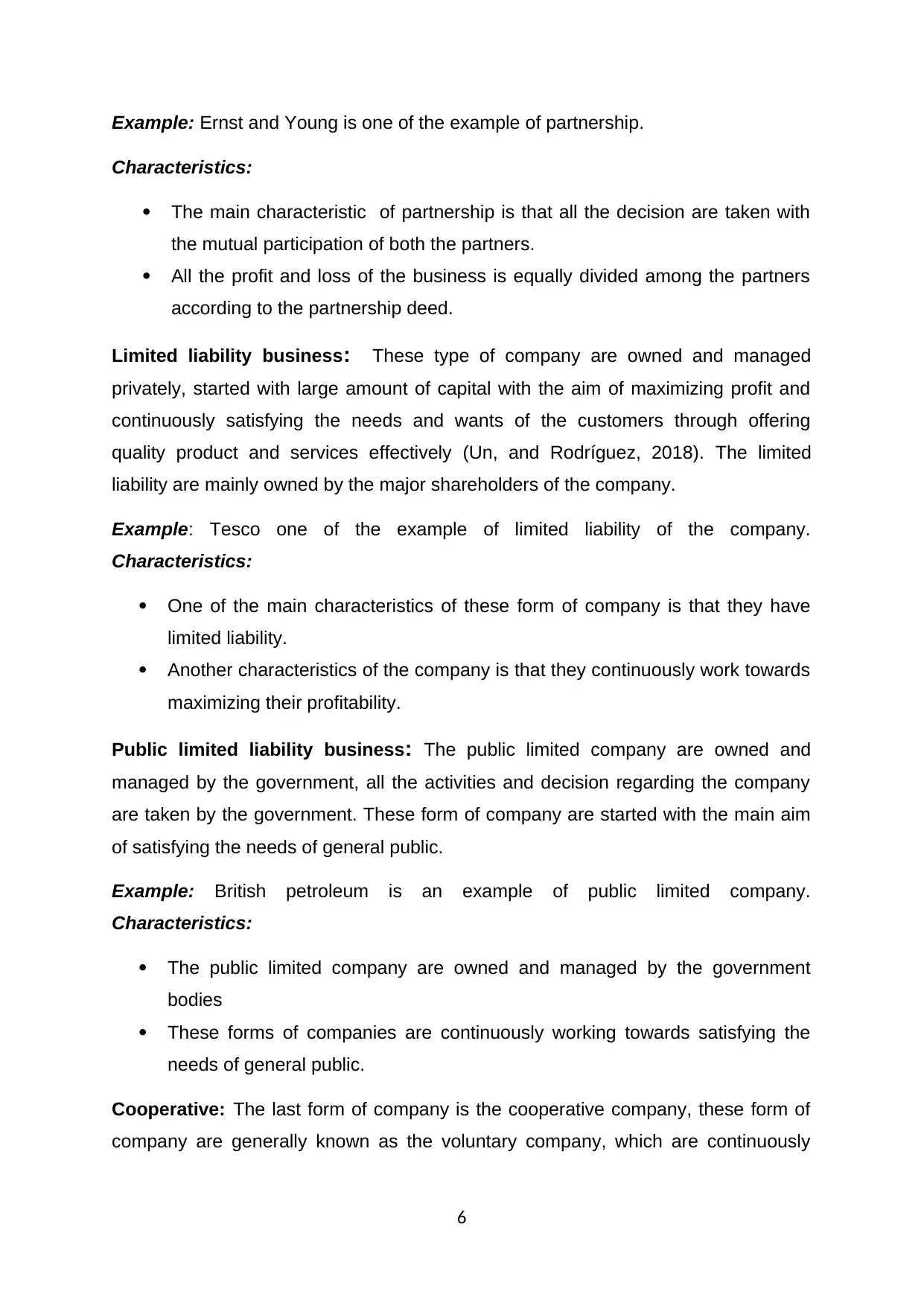
Example: Ernst and Young is one of the example of partnership.
Characteristics:
The main characteristic of partnership is that all the decision are taken with
the mutual participation of both the partners.
All the profit and loss of the business is equally divided among the partners
according to the partnership deed.
Limited liability business: These type of company are owned and managed
privately, started with large amount of capital with the aim of maximizing profit and
continuously satisfying the needs and wants of the customers through offering
quality product and services effectively (Un, and Rodríguez, 2018). The limited
liability are mainly owned by the major shareholders of the company.
Example: Tesco one of the example of limited liability of the company.
Characteristics:
One of the main characteristics of these form of company is that they have
limited liability.
Another characteristics of the company is that they continuously work towards
maximizing their profitability.
Public limited liability business: The public limited company are owned and
managed by the government, all the activities and decision regarding the company
are taken by the government. These form of company are started with the main aim
of satisfying the needs of general public.
Example: British petroleum is an example of public limited company.
Characteristics:
The public limited company are owned and managed by the government
bodies
These forms of companies are continuously working towards satisfying the
needs of general public.
Cooperative: The last form of company is the cooperative company, these form of
company are generally known as the voluntary company, which are continuously
6
Characteristics:
The main characteristic of partnership is that all the decision are taken with
the mutual participation of both the partners.
All the profit and loss of the business is equally divided among the partners
according to the partnership deed.
Limited liability business: These type of company are owned and managed
privately, started with large amount of capital with the aim of maximizing profit and
continuously satisfying the needs and wants of the customers through offering
quality product and services effectively (Un, and Rodríguez, 2018). The limited
liability are mainly owned by the major shareholders of the company.
Example: Tesco one of the example of limited liability of the company.
Characteristics:
One of the main characteristics of these form of company is that they have
limited liability.
Another characteristics of the company is that they continuously work towards
maximizing their profitability.
Public limited liability business: The public limited company are owned and
managed by the government, all the activities and decision regarding the company
are taken by the government. These form of company are started with the main aim
of satisfying the needs of general public.
Example: British petroleum is an example of public limited company.
Characteristics:
The public limited company are owned and managed by the government
bodies
These forms of companies are continuously working towards satisfying the
needs of general public.
Cooperative: The last form of company is the cooperative company, these form of
company are generally known as the voluntary company, which are continuously
6
Paraphrase This Document
Need a fresh take? Get an instant paraphrase of this document with our AI Paraphraser
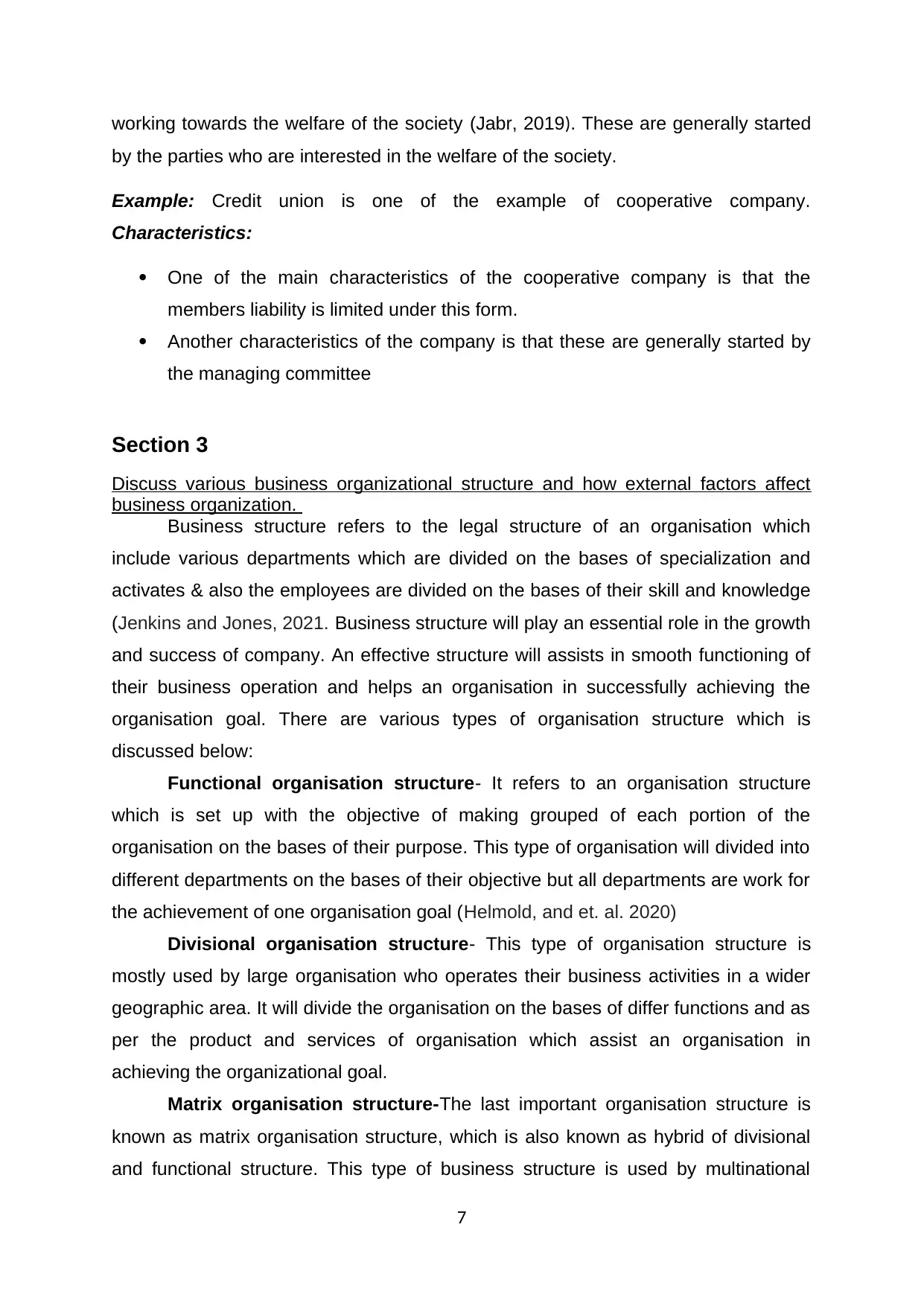
working towards the welfare of the society (Jabr, 2019). These are generally started
by the parties who are interested in the welfare of the society.
Example: Credit union is one of the example of cooperative company.
Characteristics:
One of the main characteristics of the cooperative company is that the
members liability is limited under this form.
Another characteristics of the company is that these are generally started by
the managing committee
Section 3
Discuss various business organizational structure and how external factors affect
business organization.
Business structure refers to the legal structure of an organisation which
include various departments which are divided on the bases of specialization and
activates & also the employees are divided on the bases of their skill and knowledge
(Jenkins and Jones, 2021. Business structure will play an essential role in the growth
and success of company. An effective structure will assists in smooth functioning of
their business operation and helps an organisation in successfully achieving the
organisation goal. There are various types of organisation structure which is
discussed below:
Functional organisation structure- It refers to an organisation structure
which is set up with the objective of making grouped of each portion of the
organisation on the bases of their purpose. This type of organisation will divided into
different departments on the bases of their objective but all departments are work for
the achievement of one organisation goal (Helmold, and et. al. 2020)
Divisional organisation structure- This type of organisation structure is
mostly used by large organisation who operates their business activities in a wider
geographic area. It will divide the organisation on the bases of differ functions and as
per the product and services of organisation which assist an organisation in
achieving the organizational goal.
Matrix organisation structure-The last important organisation structure is
known as matrix organisation structure, which is also known as hybrid of divisional
and functional structure. This type of business structure is used by multinational
7
by the parties who are interested in the welfare of the society.
Example: Credit union is one of the example of cooperative company.
Characteristics:
One of the main characteristics of the cooperative company is that the
members liability is limited under this form.
Another characteristics of the company is that these are generally started by
the managing committee
Section 3
Discuss various business organizational structure and how external factors affect
business organization.
Business structure refers to the legal structure of an organisation which
include various departments which are divided on the bases of specialization and
activates & also the employees are divided on the bases of their skill and knowledge
(Jenkins and Jones, 2021. Business structure will play an essential role in the growth
and success of company. An effective structure will assists in smooth functioning of
their business operation and helps an organisation in successfully achieving the
organisation goal. There are various types of organisation structure which is
discussed below:
Functional organisation structure- It refers to an organisation structure
which is set up with the objective of making grouped of each portion of the
organisation on the bases of their purpose. This type of organisation will divided into
different departments on the bases of their objective but all departments are work for
the achievement of one organisation goal (Helmold, and et. al. 2020)
Divisional organisation structure- This type of organisation structure is
mostly used by large organisation who operates their business activities in a wider
geographic area. It will divide the organisation on the bases of differ functions and as
per the product and services of organisation which assist an organisation in
achieving the organizational goal.
Matrix organisation structure-The last important organisation structure is
known as matrix organisation structure, which is also known as hybrid of divisional
and functional structure. This type of business structure is used by multinational
7
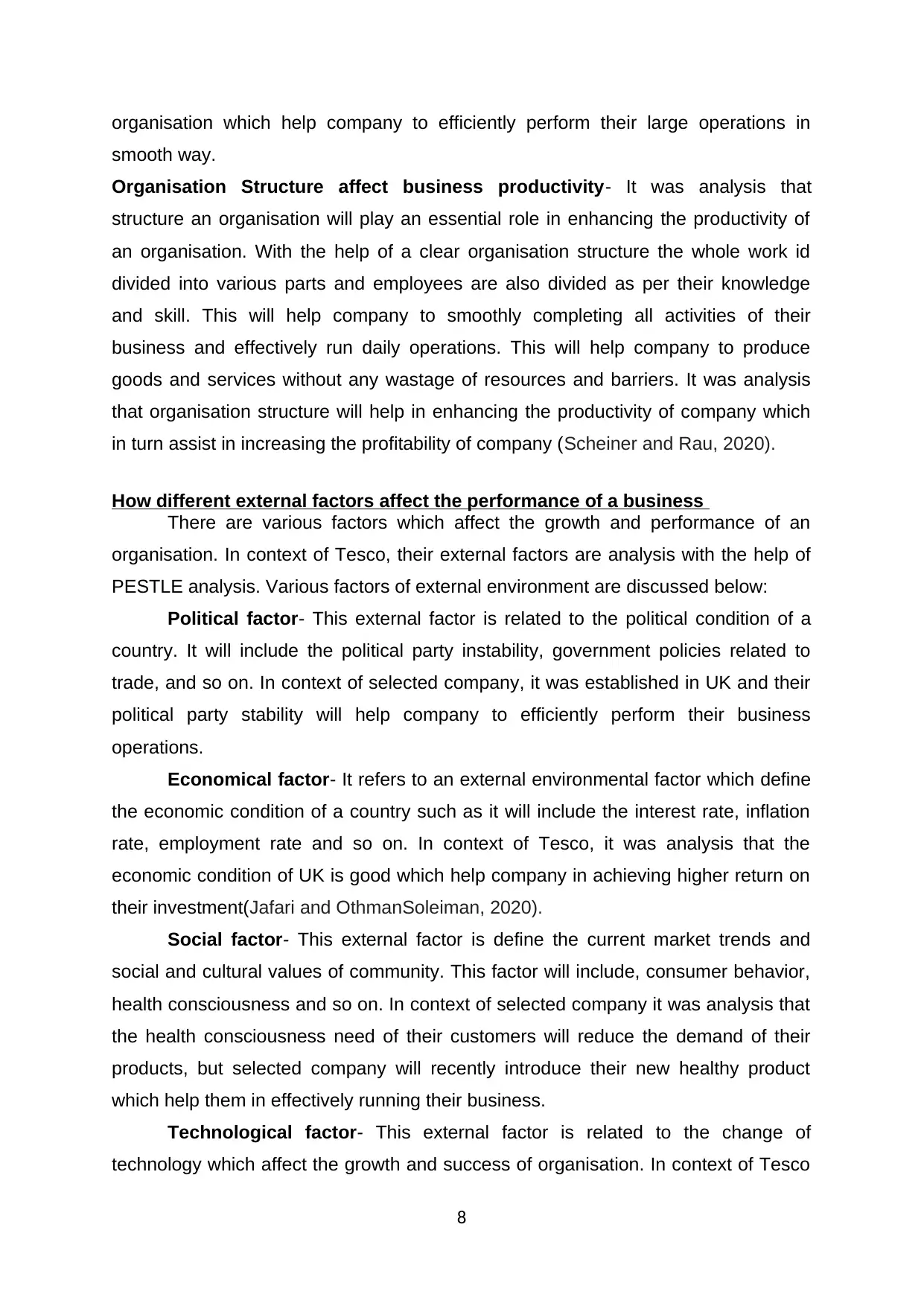
organisation which help company to efficiently perform their large operations in
smooth way.
Organisation Structure affect business productivity- It was analysis that
structure an organisation will play an essential role in enhancing the productivity of
an organisation. With the help of a clear organisation structure the whole work id
divided into various parts and employees are also divided as per their knowledge
and skill. This will help company to smoothly completing all activities of their
business and effectively run daily operations. This will help company to produce
goods and services without any wastage of resources and barriers. It was analysis
that organisation structure will help in enhancing the productivity of company which
in turn assist in increasing the profitability of company (Scheiner and Rau, 2020).
How different external factors affect the performance of a business
There are various factors which affect the growth and performance of an
organisation. In context of Tesco, their external factors are analysis with the help of
PESTLE analysis. Various factors of external environment are discussed below:
Political factor- This external factor is related to the political condition of a
country. It will include the political party instability, government policies related to
trade, and so on. In context of selected company, it was established in UK and their
political party stability will help company to efficiently perform their business
operations.
Economical factor- It refers to an external environmental factor which define
the economic condition of a country such as it will include the interest rate, inflation
rate, employment rate and so on. In context of Tesco, it was analysis that the
economic condition of UK is good which help company in achieving higher return on
their investment(Jafari and OthmanSoleiman, 2020).
Social factor- This external factor is define the current market trends and
social and cultural values of community. This factor will include, consumer behavior,
health consciousness and so on. In context of selected company it was analysis that
the health consciousness need of their customers will reduce the demand of their
products, but selected company will recently introduce their new healthy product
which help them in effectively running their business.
Technological factor- This external factor is related to the change of
technology which affect the growth and success of organisation. In context of Tesco
8
smooth way.
Organisation Structure affect business productivity- It was analysis that
structure an organisation will play an essential role in enhancing the productivity of
an organisation. With the help of a clear organisation structure the whole work id
divided into various parts and employees are also divided as per their knowledge
and skill. This will help company to smoothly completing all activities of their
business and effectively run daily operations. This will help company to produce
goods and services without any wastage of resources and barriers. It was analysis
that organisation structure will help in enhancing the productivity of company which
in turn assist in increasing the profitability of company (Scheiner and Rau, 2020).
How different external factors affect the performance of a business
There are various factors which affect the growth and performance of an
organisation. In context of Tesco, their external factors are analysis with the help of
PESTLE analysis. Various factors of external environment are discussed below:
Political factor- This external factor is related to the political condition of a
country. It will include the political party instability, government policies related to
trade, and so on. In context of selected company, it was established in UK and their
political party stability will help company to efficiently perform their business
operations.
Economical factor- It refers to an external environmental factor which define
the economic condition of a country such as it will include the interest rate, inflation
rate, employment rate and so on. In context of Tesco, it was analysis that the
economic condition of UK is good which help company in achieving higher return on
their investment(Jafari and OthmanSoleiman, 2020).
Social factor- This external factor is define the current market trends and
social and cultural values of community. This factor will include, consumer behavior,
health consciousness and so on. In context of selected company it was analysis that
the health consciousness need of their customers will reduce the demand of their
products, but selected company will recently introduce their new healthy product
which help them in effectively running their business.
Technological factor- This external factor is related to the change of
technology which affect the growth and success of organisation. In context of Tesco
8
⊘ This is a preview!⊘
Do you want full access?
Subscribe today to unlock all pages.

Trusted by 1+ million students worldwide
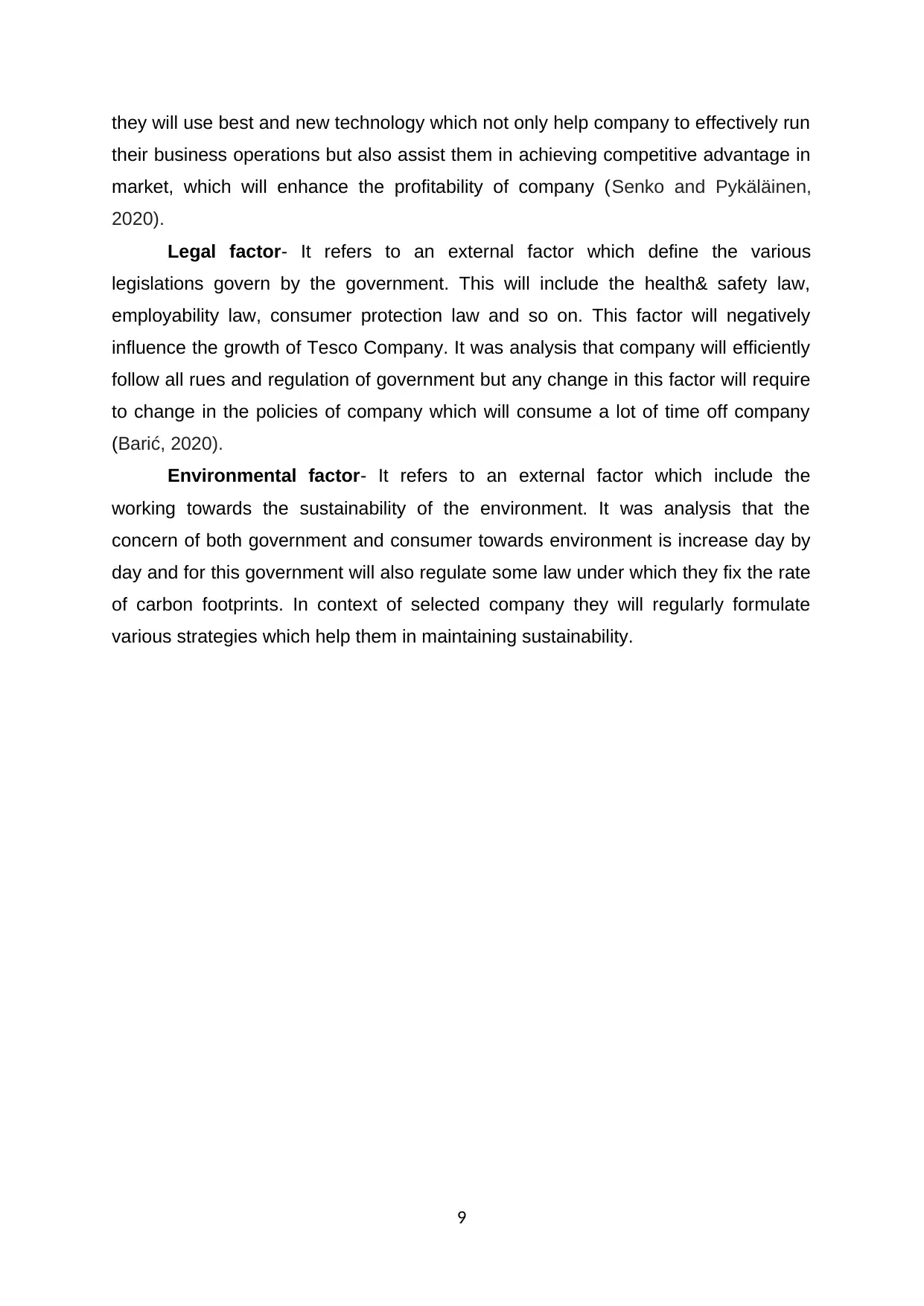
they will use best and new technology which not only help company to effectively run
their business operations but also assist them in achieving competitive advantage in
market, which will enhance the profitability of company (Senko and Pykäläinen,
2020).
Legal factor- It refers to an external factor which define the various
legislations govern by the government. This will include the health& safety law,
employability law, consumer protection law and so on. This factor will negatively
influence the growth of Tesco Company. It was analysis that company will efficiently
follow all rues and regulation of government but any change in this factor will require
to change in the policies of company which will consume a lot of time off company
(Barić, 2020).
Environmental factor- It refers to an external factor which include the
working towards the sustainability of the environment. It was analysis that the
concern of both government and consumer towards environment is increase day by
day and for this government will also regulate some law under which they fix the rate
of carbon footprints. In context of selected company they will regularly formulate
various strategies which help them in maintaining sustainability.
9
their business operations but also assist them in achieving competitive advantage in
market, which will enhance the profitability of company (Senko and Pykäläinen,
2020).
Legal factor- It refers to an external factor which define the various
legislations govern by the government. This will include the health& safety law,
employability law, consumer protection law and so on. This factor will negatively
influence the growth of Tesco Company. It was analysis that company will efficiently
follow all rues and regulation of government but any change in this factor will require
to change in the policies of company which will consume a lot of time off company
(Barić, 2020).
Environmental factor- It refers to an external factor which include the
working towards the sustainability of the environment. It was analysis that the
concern of both government and consumer towards environment is increase day by
day and for this government will also regulate some law under which they fix the rate
of carbon footprints. In context of selected company they will regularly formulate
various strategies which help them in maintaining sustainability.
9
Paraphrase This Document
Need a fresh take? Get an instant paraphrase of this document with our AI Paraphraser
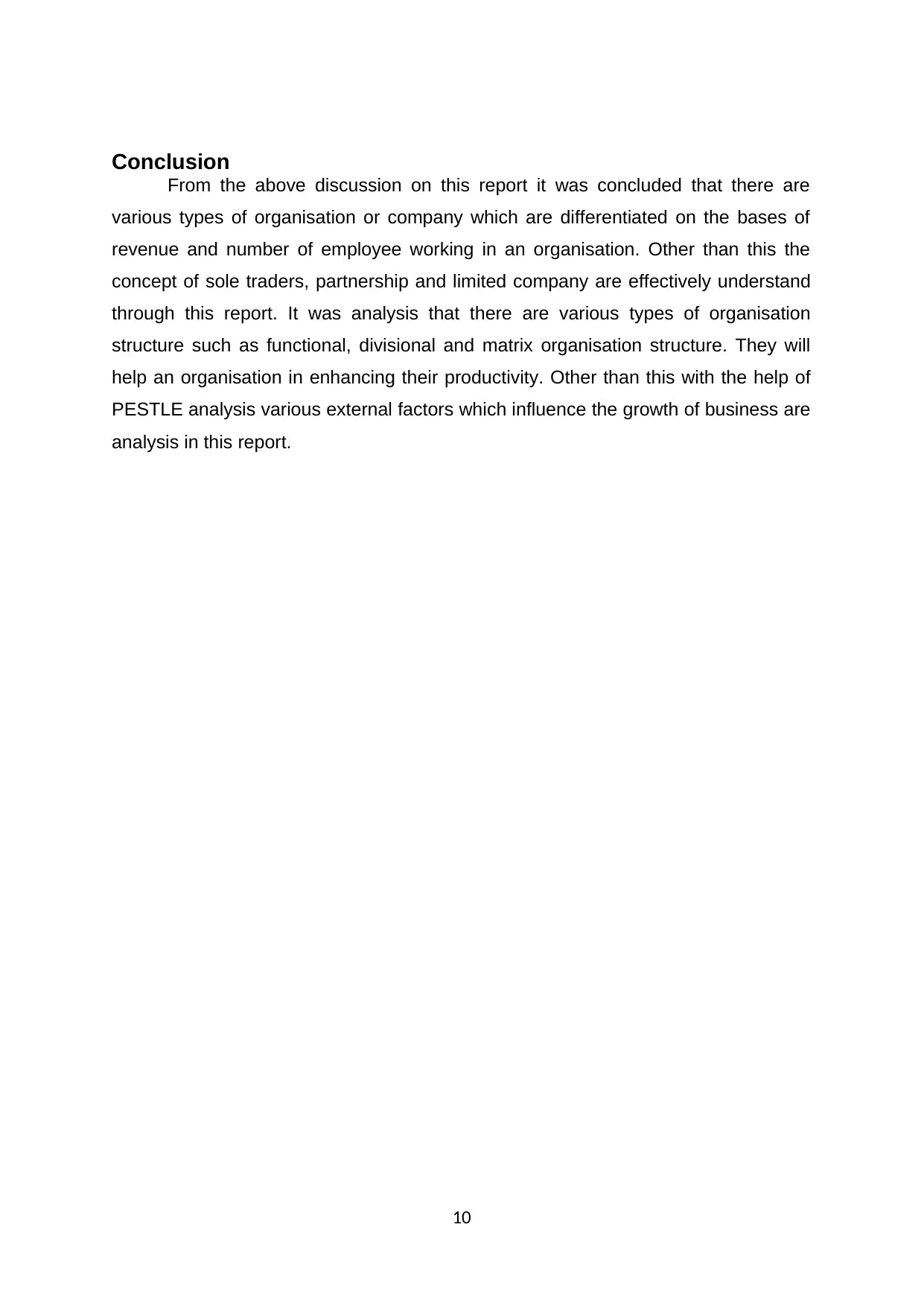
Conclusion
From the above discussion on this report it was concluded that there are
various types of organisation or company which are differentiated on the bases of
revenue and number of employee working in an organisation. Other than this the
concept of sole traders, partnership and limited company are effectively understand
through this report. It was analysis that there are various types of organisation
structure such as functional, divisional and matrix organisation structure. They will
help an organisation in enhancing their productivity. Other than this with the help of
PESTLE analysis various external factors which influence the growth of business are
analysis in this report.
10
From the above discussion on this report it was concluded that there are
various types of organisation or company which are differentiated on the bases of
revenue and number of employee working in an organisation. Other than this the
concept of sole traders, partnership and limited company are effectively understand
through this report. It was analysis that there are various types of organisation
structure such as functional, divisional and matrix organisation structure. They will
help an organisation in enhancing their productivity. Other than this with the help of
PESTLE analysis various external factors which influence the growth of business are
analysis in this report.
10
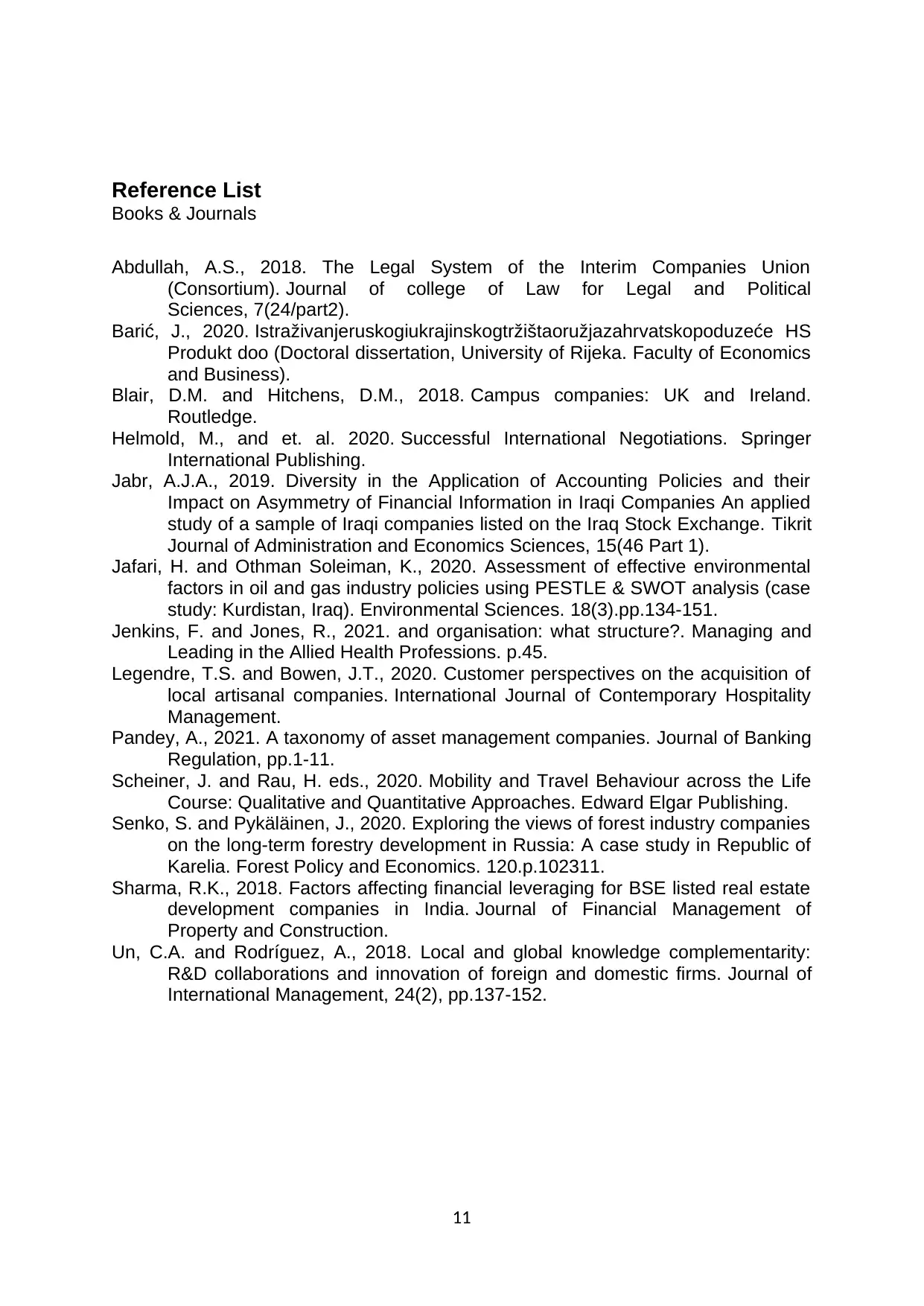
Reference List
Books & Journals
Abdullah, A.S., 2018. The Legal System of the Interim Companies Union
(Consortium). Journal of college of Law for Legal and Political
Sciences, 7(24/part2).
Barić, J., 2020. Istraživanjeruskogiukrajinskogtržištaoružjazahrvatskopoduzeće HS
Produkt doo (Doctoral dissertation, University of Rijeka. Faculty of Economics
and Business).
Blair, D.M. and Hitchens, D.M., 2018. Campus companies: UK and Ireland.
Routledge.
Helmold, M., and et. al. 2020. Successful International Negotiations. Springer
International Publishing.
Jabr, A.J.A., 2019. Diversity in the Application of Accounting Policies and their
Impact on Asymmetry of Financial Information in Iraqi Companies An applied
study of a sample of Iraqi companies listed on the Iraq Stock Exchange. Tikrit
Journal of Administration and Economics Sciences, 15(46 Part 1).
Jafari, H. and Othman Soleiman, K., 2020. Assessment of effective environmental
factors in oil and gas industry policies using PESTLE & SWOT analysis (case
study: Kurdistan, Iraq). Environmental Sciences. 18(3).pp.134-151.
Jenkins, F. and Jones, R., 2021. and organisation: what structure?. Managing and
Leading in the Allied Health Professions. p.45.
Legendre, T.S. and Bowen, J.T., 2020. Customer perspectives on the acquisition of
local artisanal companies. International Journal of Contemporary Hospitality
Management.
Pandey, A., 2021. A taxonomy of asset management companies. Journal of Banking
Regulation, pp.1-11.
Scheiner, J. and Rau, H. eds., 2020. Mobility and Travel Behaviour across the Life
Course: Qualitative and Quantitative Approaches. Edward Elgar Publishing.
Senko, S. and Pykäläinen, J., 2020. Exploring the views of forest industry companies
on the long-term forestry development in Russia: A case study in Republic of
Karelia. Forest Policy and Economics. 120.p.102311.
Sharma, R.K., 2018. Factors affecting financial leveraging for BSE listed real estate
development companies in India. Journal of Financial Management of
Property and Construction.
Un, C.A. and Rodríguez, A., 2018. Local and global knowledge complementarity:
R&D collaborations and innovation of foreign and domestic firms. Journal of
International Management, 24(2), pp.137-152.
11
Books & Journals
Abdullah, A.S., 2018. The Legal System of the Interim Companies Union
(Consortium). Journal of college of Law for Legal and Political
Sciences, 7(24/part2).
Barić, J., 2020. Istraživanjeruskogiukrajinskogtržištaoružjazahrvatskopoduzeće HS
Produkt doo (Doctoral dissertation, University of Rijeka. Faculty of Economics
and Business).
Blair, D.M. and Hitchens, D.M., 2018. Campus companies: UK and Ireland.
Routledge.
Helmold, M., and et. al. 2020. Successful International Negotiations. Springer
International Publishing.
Jabr, A.J.A., 2019. Diversity in the Application of Accounting Policies and their
Impact on Asymmetry of Financial Information in Iraqi Companies An applied
study of a sample of Iraqi companies listed on the Iraq Stock Exchange. Tikrit
Journal of Administration and Economics Sciences, 15(46 Part 1).
Jafari, H. and Othman Soleiman, K., 2020. Assessment of effective environmental
factors in oil and gas industry policies using PESTLE & SWOT analysis (case
study: Kurdistan, Iraq). Environmental Sciences. 18(3).pp.134-151.
Jenkins, F. and Jones, R., 2021. and organisation: what structure?. Managing and
Leading in the Allied Health Professions. p.45.
Legendre, T.S. and Bowen, J.T., 2020. Customer perspectives on the acquisition of
local artisanal companies. International Journal of Contemporary Hospitality
Management.
Pandey, A., 2021. A taxonomy of asset management companies. Journal of Banking
Regulation, pp.1-11.
Scheiner, J. and Rau, H. eds., 2020. Mobility and Travel Behaviour across the Life
Course: Qualitative and Quantitative Approaches. Edward Elgar Publishing.
Senko, S. and Pykäläinen, J., 2020. Exploring the views of forest industry companies
on the long-term forestry development in Russia: A case study in Republic of
Karelia. Forest Policy and Economics. 120.p.102311.
Sharma, R.K., 2018. Factors affecting financial leveraging for BSE listed real estate
development companies in India. Journal of Financial Management of
Property and Construction.
Un, C.A. and Rodríguez, A., 2018. Local and global knowledge complementarity:
R&D collaborations and innovation of foreign and domestic firms. Journal of
International Management, 24(2), pp.137-152.
11
⊘ This is a preview!⊘
Do you want full access?
Subscribe today to unlock all pages.

Trusted by 1+ million students worldwide
1 out of 12
Related Documents
Your All-in-One AI-Powered Toolkit for Academic Success.
+13062052269
info@desklib.com
Available 24*7 on WhatsApp / Email
![[object Object]](/_next/static/media/star-bottom.7253800d.svg)
Unlock your academic potential
Copyright © 2020–2025 A2Z Services. All Rights Reserved. Developed and managed by ZUCOL.





